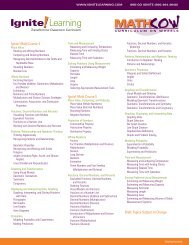The Silent Epidemic: Perspectives of High School ... - Ignite! Learning
The Silent Epidemic: Perspectives of High School ... - Ignite! Learning
The Silent Epidemic: Perspectives of High School ... - Ignite! Learning
You also want an ePaper? Increase the reach of your titles
YUMPU automatically turns print PDFs into web optimized ePapers that Google loves.
<strong>The</strong> <strong>Silent</strong> <strong>Epidemic</strong><br />
good response rates. 54 Concerns have been<br />
raised, however, about the exclusion <strong>of</strong> certain<br />
populations (military and institutionalized), the<br />
accuracy <strong>of</strong> counting young minority males, and<br />
the inclusion <strong>of</strong> individuals who may have received<br />
a General Educational Development (GED)<br />
certificate instead <strong>of</strong> a regular diploma. 55<br />
<strong>The</strong> nation’s Governors have convened to<br />
move toward more accurate reporting systems<br />
and to ensure a certain level <strong>of</strong> uniformity, accuracy,<br />
transparency and accountability in their data<br />
collection and reporting. We believe such an<br />
effort is merited as it relates to the Current<br />
Population Survey, the Common Core <strong>of</strong> Data<br />
compiled by the U.S. Department <strong>of</strong> Education’s<br />
National Center for Education Statistics (NCES),<br />
and data from the NCES Longitudinal Studies<br />
Program. 56 We also believe it would make sense,<br />
in light <strong>of</strong> the renewed efforts <strong>of</strong> the Governors,<br />
to more carefully determine what the federal role<br />
should be in data collection and reporting on<br />
these subjects, and how any federal effort could<br />
compliment the strengthened state efforts. Does<br />
the state by state data collection, with comparable<br />
data sets, render the Current Population<br />
Survey (CPS) in this regard unnecessary or confusing<br />
in any ways? In light <strong>of</strong> the fact that the<br />
CPS is the only source <strong>of</strong> long-term trends in<br />
dropout and completion rates, is there still a role<br />
for the Census to play that is complimentary <strong>of</strong><br />
the new state efforts? Should the Common Core<br />
<strong>of</strong> Data be adjusted in any way? We also note<br />
that while the federal government spends $40<br />
million on the National Assessment <strong>of</strong> Educational<br />
Progress (NAEP), it is estimated to spend less<br />
than $1 million on dropout statistics. 57 This may<br />
be an appropriate breakdown <strong>of</strong> the federal investment,<br />
given the primary role <strong>of</strong> the states in such<br />
efforts, but we would encourage further discussion<br />
<strong>of</strong> what the federal role should be in data<br />
collection in these areas since accurate data is<br />
so critical to charting progress in addressing the<br />
dropout epidemic.<br />
Better Incentives Under Federal Law<br />
<strong>The</strong> passage <strong>of</strong> the No Child Left Behind law<br />
prompts public schools all across the country to<br />
be increasingly concerned about graduation rates.<br />
18<br />
For the first time under federal law, schools must<br />
demonstrate that they are making “adequate<br />
yearly progress” on both academic performance<br />
and graduation rates. Including a focus in the law<br />
on graduation rates was important as a companion<br />
to testing, so that the schools would have<br />
incentives to ensure that every child, including<br />
those in danger <strong>of</strong> not graduating, were given the<br />
help they needed to succeed. Having additional<br />
data to determine if there were disproportionate<br />
effects on minority or other groups was important<br />
for tracking both annual progress on test scores<br />
and annual progress on graduation rates.<br />
<strong>The</strong>re is substantial concern that the regulations<br />
implementing the No Child Left Behind law<br />
are not fulfilling the promise <strong>of</strong> graduation rate<br />
accountability. Some express concerns that<br />
schools and states can set whatever goals they<br />
wish for making progress on graduation rates and<br />
that there is no requirement to provide graduation<br />
data for racial and ethnic subgroups, even though<br />
such accountability was central to the law. 58 <strong>The</strong><br />
overarching concern is that, if this system <strong>of</strong> federal<br />
incentives is not brought in line with the<br />
original intent <strong>of</strong> the law, the law will have the<br />
unintended effect <strong>of</strong> giving schools an incentive<br />
to “push out” low-performing students whose test<br />
scores would bring down school averages, threatening<br />
their demonstration <strong>of</strong> adequate yearly<br />
progress, which eventually carries tough sanctions<br />
for failure. If schools are only rewarded for<br />
raising their test scores, and the federal rules<br />
have no teeth with respect to graduation rates,<br />
schools would be expected to focus far more<br />
attention on test scores and far less attention on<br />
graduation rates. Perverse incentives to “push<br />
out” (or rather, we think, not make the necessary<br />
effort to support) low-performing students would<br />
be created with bad effects. <strong>The</strong>re is always a<br />
natural tension between ensuring accountability<br />
and providing sufficient flexibility to make programs<br />
work. Correcting perverse incentives such<br />
as these, however, should be a priority to ensure<br />
the schools have the right incentives to close the<br />
achievement gap and strengthen student performance,<br />
while at the same time raising the<br />
graduation rate.








